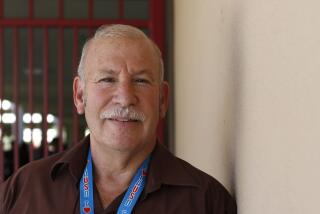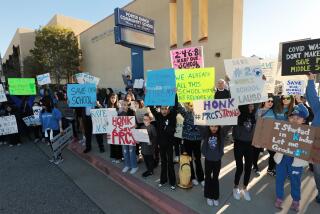How L.A. Unified could reduce absenteeism, if it listens to outside advisors

Two years ago, an independent policy group warned Los Angeles Unified School District officials that high levels of student absenteeism were eating away at the district’s finances.
Since then, the problem has not gone away. As L.A. Unified’s student enrollment has continued to shrink, the percentage of chronically absent students has remained essentially unchanged — a concern because funding is based on attendance. According to one estimate, absenteeism cost the nation’s second-largest school district $20 million last year, at a time when it’s desperately in search of new revenue.
Now, a different advisory body is trying again.
Assembled by philanthropist and former Los Angeles Times publisher Austin Beutner to work with Supt. Michelle King, the latest task force is made up of civic leaders and education experts.
On Tuesday, the group presented L.A. Unified’s school board with its first set of recommendations, aimed at encouraging students who frequently skip class to show up more often.
Their report includes ideas pulled from other districts, including Philadelphia, Cleveland and Long Beach Unified. Among them is a proposal to send direct mail to parents of students who are at risk of missing too much school. Another would dispatch volunteers to canvas homes and businesses near schools with high rates of absenteeism.
“This campaign will be a collaborative effort,” Beutner said. “If we can help shift the curve just one day for each student, that will generate $30 million in additional revenue for the district, not to mention better learning.”
Acting Supt. Vivian Ekchian, who is filling in while King is on medical leave, said the district has committed to testing the group’s proposals in select schools where truancy is prevalent. The pilot programs are expected to cost $250,000, Beutner said, a cost the district and the task force will split. Officials hope that if the new effort succeeds in improving attendance, increased state funding would cover the cost of expanding them district-wide.
Last year, about 80,000 of L.A. Unified’s students missed 15 or more days of school, the threshold for chronic absenteeism. And although the district has set targets for improvement, the task force report said it “does not have an adequate plan in place” to meet them.
Students with 15 or more absences made up 14% of L.A. Unified’s more than 500,000 students last year. An additional 18% of students missed between 8 and 14 days. The highest rates of truancy are among African American students and among kindergartners and high school students.
The causes are many — transportation problems, safety concerns, immigration status — and the effects are serious. Research shows that students who are absent frequently are more likely to fall behind and to drop out of school. And because funding in California is tied to attendance, L.A. Unified loses money on each absence.
District schools could see new anti-truancy measures as early as January.
In its report, the group proposes a citywide awareness campaign that would be followed by several closely studied pilot programs.
One of these would require the district to hire a company called In Class Today, which targets parents of frequently absent students with personalized mailers showing how often their children have missed class compared to their peers.
If this sounds like a tactic adopted from get-out-the-vote efforts, that’s because it is. The brainchild of behavioral scientist and former Democratic pollster Todd Rogers, In Class Today claims to have reduced chronic absenteeism in Philadelphia schools by as much as 10%.
“Families often aren’t aware that absences are adding up to so much time that their children might be academically at risk,” said Hedy Chang, director of Attendance Works, a San Francisco-based policy group. “If I can, for five cents, get a letter out there that gets a kid to show up for one more day of school, that’s a net benefit for L.A. Unified.”
Another of the group’s proposals would have the district call and text parents about their children’s attendance. And yet another would give bonuses to schools based on their attendance rates, rewarding them with cash they could spend however they’d like — a tactic used by Long Beach Unified.
These steps are helpful, Chang said, but typically aren’t sufficient to get the most challenging students back into class.
For those students, the task force recommends more one-on-one counseling, although neither the task force nor the district has said it plans to hire more attendance counselors, known in district jargon as Pupil Services and Attendance Counselors.
Currently, the district spends more than $40 million annually to fight absenteeism. More than half of it is used to pay the salaries of the attendance counselors, who focus on students in foster care or homeless shelters.
“I’ve seen report after report and committee after committee. … L.A. has the greatest plans in the world and probably the worst follow-through,” said board member Richard Vladovic, noting the district’s many tries to improve attendance. “I feel very energized by this and hopeful.”
Twitter: @annamphillips
More to Read
Start your day right
Sign up for Essential California for news, features and recommendations from the L.A. Times and beyond in your inbox six days a week.
You may occasionally receive promotional content from the Los Angeles Times.







